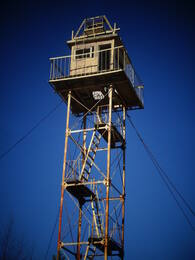“Wind. Spite. And the Livonian flag.” (fragment) - Ghost Ships and Barbed Wire
Gunta Kārkliņa's memories of the Soviet era on the Livonian coast - how did the boat cemetery come about there?
However, the years of occupation have left their harsh marks. Turning along a forest path, suddenly several fishing boats grown into the trees and the ground open up to the view. Wrecks. Like ghost ships, like shadows of the past. Half-collapsed, they seem to be trying with their last strength to maintain their dignity and defiance. Until World War II, there were 48 fishing boats in the village of Mazirbe. Then the Soviet regime came with a thirst for destruction and devastation. The order was strict – burn the boats! “But the Livs are stubborn,” says Gunta. “Not everyone burned! The boats were pulled further ashore. With the thought that the occupiers would soon leave… Everyone hoped that the English would come to help and Latvia would be free again.” Historical sources state that the boat cemetery was created after 1960, because border guards did not allow them to be burned on the shore, as was traditionally done on Midsummer Eve with boats that had served their time. Those boats remained there. Decades passed, and the boats grew into trees. The ghostly wrecks are such a vivid testimony of an era that official historical writings pale in comparison.
Among the absurd prohibitions of the Soviet era, it should also be mentioned that the sea was not “open” to everyone. Norms were set for coastal fishermen, a pass regime was introduced, and the ancient traditions of seafarers were destroyed. Every evening, the beach was trodden on by horses, and in later years – by tractor. So that there would be traces left on the freshly plowed land if anyone thought of fleeing across the sea to Ziedrija, which was affected by “rotting capitalism”. Only a strip of beach about 200 meters wide was open, with a barbed wire fence on both sides and where border guards with dogs patrolled. There was also a sign: “Stop! Beach open until 22.00”.
Did the Soviet government really think that people would flee across the sea to Ziedrija? “You have to laugh! No one even tried to flee anywhere… In the first post-war years, yes, but later there were no such thoughts,” says Gunta and adds that they, the children of the village, lived their children’s lives, did not think much about adult things, and it was not the worst childhood at all. Maybe not as sunny as it might have been in another time and place, but nice enough that now, years later, they remember it with warmth in their hearts. Well, yes, poverty… But where was there none? Mazirbe had both a fishing and an ordinary, agricultural collective farm. And, as was customary in Soviet times, you couldn’t buy anything good in the shops. Everything – one single deficit! The village girls could only dream of becoming a state employee. So they had to use their creative thinking and make something out of nothing. A sewing machine was considered a real treasure!” My mother knew how to sew, and at that time it was a million. She sewed a school dress for me from my father's old jacket. Ladies sewed dresses from feather stuffing, which was meant for pillows – pink, blue, orange. But if they got cotton wool!...” Gunta's eyes sparkle in her memories. “Then we would walk around in one dress all summer.” And then we could also go to a ball at the Livonian Culture House. Social evenings in the style of the "Goluboj ogoņok" (TV show "Blue Flame"), which was popular throughout the Soviet Union, were said to be very popular in the Soviet years, with a program and dances. Of course, the soldiers of the military unit stationed in Mazirbe also came to social events. “We had such a lot of guys that you could beat a tree,” Gunta laughs. Didn't the local girls marry? "They got married! Almost all of them! Russians, Lithuanians, Latvians too... There were quite a few civilians and local guys."
REAL LIFE 2009 No. 21 - sent by Inese Roze (Talsi County Tourist Information Centre)
Related objects
Mazirbe border guard tower
The Soviet border defence post was located in the building that used to be a maritime school, and next to it is a well-preserved Soviet border guard watchtower. The second watchtower is located right on the shore next to a parking lot. These watchtowers are a reminder of the Soviet occupation and the times when Mazirbe was a closed border area and civilians were allowed on the shore only in specially designated places and only during the daytime. This border guard watchtower is one of the best-preserved objects of its type on the coast of Latvia. However, it designated is dangerous to climb it.





